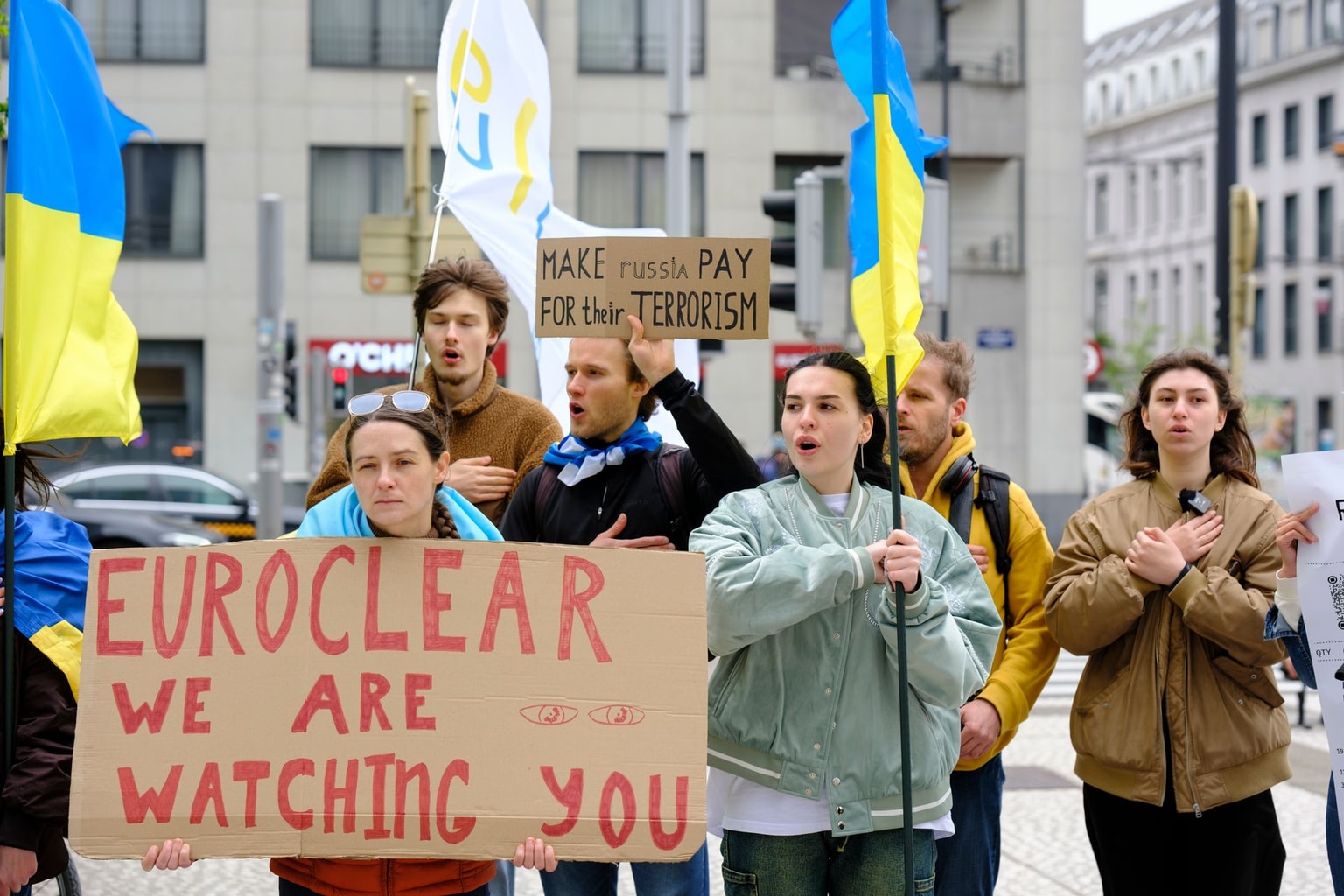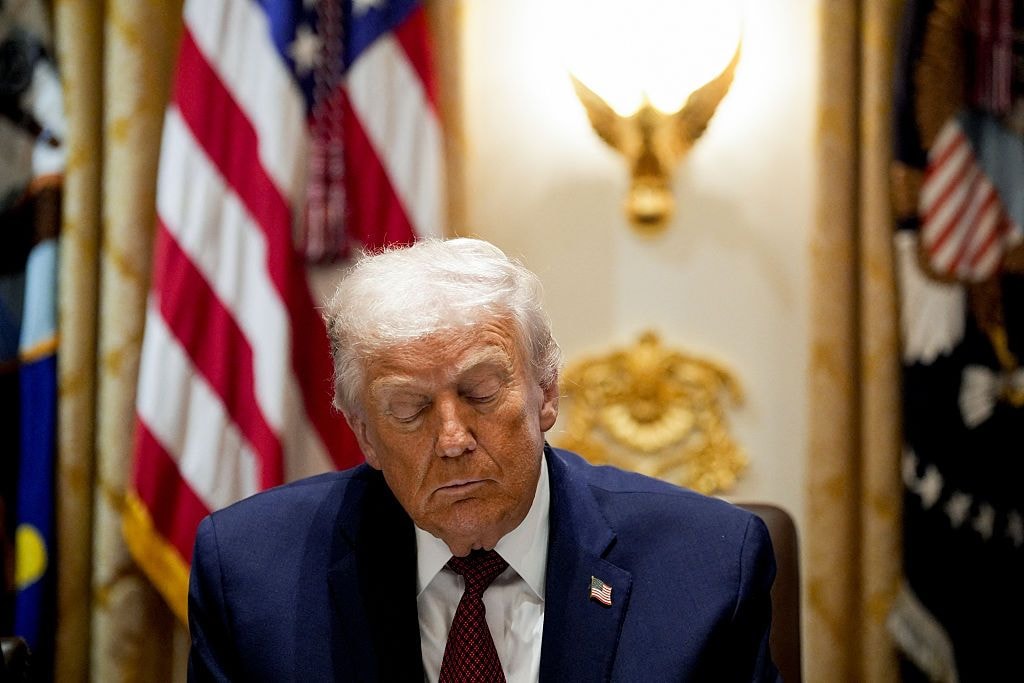Timeline of Russia's all-out war in Ukraine, month by month
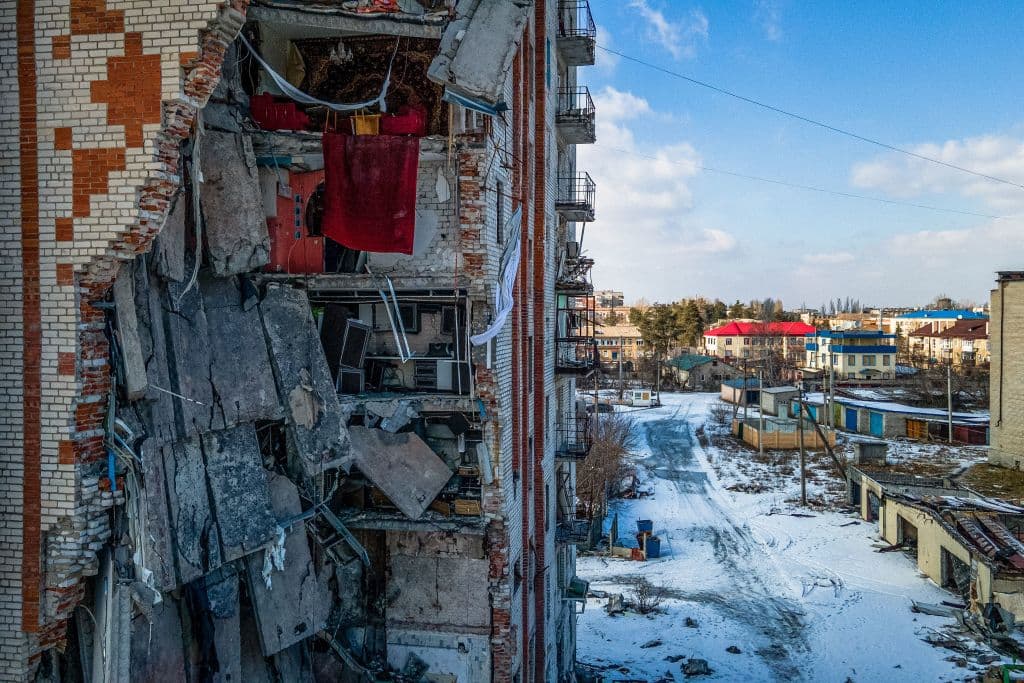
Ukraine has come a long way since the beginning of Russia’s full-scale invasion on Feb. 24, 2022.
From the Russian occupation of nearly 30% of Ukraine’s territory in February to Russia’s humiliating defeats in the north and the south, from the West’s hesitation about providing weapons to Kyiv to pledging hundreds of modern tanks, from the entire world’s doubts about Ukraine’s very chances to survive to the global admiration of the Ukrainian people’s courage — this year has forever changed Ukraine and the world.
No matter how resistant Ukraine has been, Russia’s endless brutality has also made this year full of devastation and tragedy. The all-out war has claimed the lives of thousands of civilians, forced millions to flee, and led to tens of billions of dollars in damage.
Each month presented new developments on the front line, new shifts in the diplomatic effort, new tragedies, and new victories.
Here are the main events that defined the 12 months of war in Ukraine.
February
After months of reports pointing to Russia’s preparation to invade Ukraine further, in late February, Moscow and its proxies step up hostilities in Donbas, the partially-occupied region in eastern Ukraine comprising Donetsk and Luhansk oblasts. Russia first invaded Donbas in 2014.
The Russia-installed proxies wrongfully accuse Ukraine of escalation, announce a demonstrative evacuation of women and children from Donbas to Russia, and launch a campaign to conscript all men under 55.
The following week, Russian President Vladimir Putin recognizes its enclaves in eastern Ukraine as independent states and sends its troops to the area. About 170,000 Russian servicemen are stationed at Ukraine's borders, but the Kremlin denies having plans to scale up its aggression.
Most Ukrainians are asleep when Russian President Vladimir Putin declares war on Ukraine in his address around 5 a.m. of Feb. 24. He deceitfully hides the brutal large-scale invasion behind the rhetoric of a “special military operation” to “demilitarize” Ukraine.
A mere moments after Putin’s speech is over, missiles begin raining down across Ukraine, and Russian forces attack the country from multiple directions in an attempt to behead President Volodymyr Zelensky's government and install a puppet regime. Dozens get killed within hours.
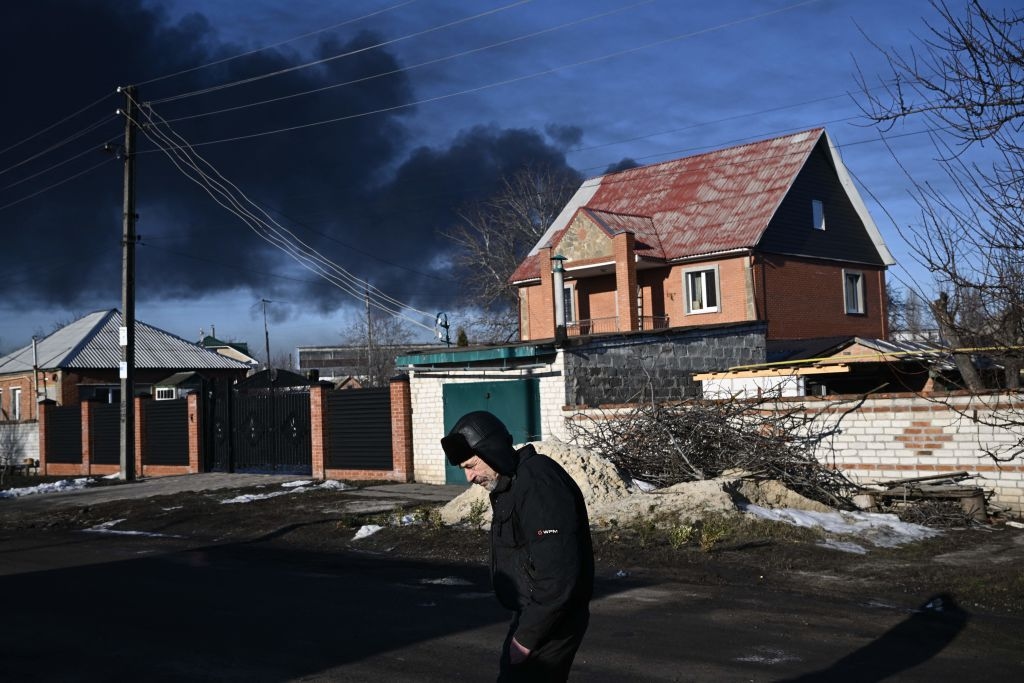
With the sudden offensive, Russia aims to catch Ukraine off-guard and inflict a quick defeat on the Armed Forces. Many experts predict the swift capture of Kyiv in the face of Moscow's “military machine.”
Shortly after Feb. 24, the U.S. government offeres Zelensky to evacuate from Kyiv, but he turns down the offer. He famously says in response: “The fight is here; I need ammunition, not a ride.”
But Russian blitz victory plans get foiled by ferocious Ukrainian resistance. The 13 defenders of the Snake Island, a tiny yet key strategic outpost in the Black Sea, become the symbol of this resistance. When Russian troops threaten to bomb the island, one of the soldiers gives an obscene response to the Russian flagship Moskva, saying, "Russian warship, go f**k yourself." The island gets occupied and the defenders end up in captivity, but their act of bravery inspires all of Ukraine to continue the fight.
Moscow fails to gain a foothold in any of the country's key cities in the first week of its invasion. Meanwhile, Ukraine officially applies to become an EU member.
March
As the fighting rages on, hundreds of thousands of Ukrainians flee their homes to the neighboring countries by train, car, or even on foot.
In response to the mass displacement, the EU makes an unprecedented move to help those fleeing the Russian violence: The member states keep their borders open and activate the temporary protection directive, which permits Ukrainians to live in any country of the bloc for at least a year.

The EU imposes severe sanctions against Russia, including blocking some of its banks from the SWIFT messaging system for international payments. Other allies, including the U.S. and the U.K., also introduce new measures against the Kremlin regime in the wake of the ongoing aggression.
Meanwhile, on the battlefield, the spring brings grim news as Russian forces occupy the southern city of Kherson, a strategic regional capital neighboring Crimea. Ukraine's south is now the site of fierce fighting.
Russia starts its siege and relentless bombardment of Mariupol, reducing the once vibrant port city in Donetsk Oblast into a landscape of rubble. Russian troops drop 50-100 bombs on the city every day, according to local authorities. A single strike at the Mariupol drama theater kills from 300-900 people, according to different estimates, who had taken shelter inside.
Moscow military also seizes control of the Zaporizhzhia Nuclear Power Plant, the largest nuclear power plant in Europe and among the 10 largest in the world, and occupies the Chornobyl power plant. Ukraine calls the occupation of the plants, as well as their shelling, an act of "nuclear terrorism."
In the north of the country, the Ukrainian military is fighting the outnumbering Russian forces near Kyiv, and in Chernihiv and Sumy oblasts.
March proves to be the deadliest month of the invasion for the civilian population, with far more civilians killed than in any other month, according to the United Nations.
To mark one month of the full-scale invasion, U.S. President Joe Biden makes a visit to Warsaw, Poland, where he meets Ukrainian refugees. He slams Putin, referring to him as a "butcher" and saying, “for God's sake, this man cannot remain in power."
April
As the Russian attempt to encircle the Ukrainian capital and install a blockade fails, the battle for Kyiv is over, with Ukraine as its victor.
Ukraine's military raises the Ukrainian flag above the Chornobyl Nuclear Power Plant, and the whole of Kyiv Oblast is declared free from occupation. The Russians also withdraw from Chernihiv and Sumy oblasts.
However, the significant victory is marred by the emerging evidence of mass executions of civilians, torture, rape, and looting during the weeks of occupation.
Bucha, a satellite town just northwest of Kyiv, is now the scene of the worst massacre committed on the European continent in the 21st century. Months after the Russian withdrawal, Bucha was still burying the bodies of unidentified victims. The gruesome images of numerous war crimes and devastating damage to the once peaceful suburbs like Irpin, Hostomel, and Borodianka shock the world.
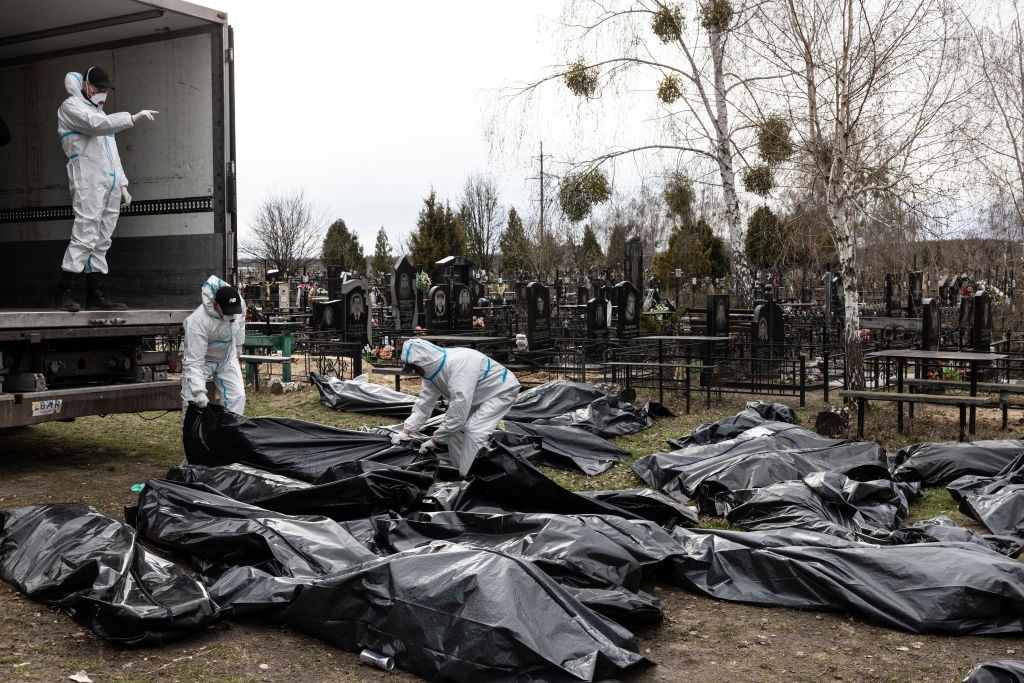
U.S. President Joe Biden calls the war in Ukraine a “genocide” for the first time, saying that “It’s become clearer and clearer that Putin is just trying to wipe out even the idea of being Ukrainian. The evidence is mounting.”
At the same time, Russia launches one of the deadliest missile strikes against civilians. The Russians hit a train station in Kramatorsk, Donetsk Oblast, where thousands of civilians were waiting for evacuation. At least 61 people were killed, and nearly 121 were injured, according to the State Security Service.
The attack comes as the war moves to the next stage — the Battle of Donbas. After failing to reach Kyiv and withdrawing from the north of Ukraine, Moscow switches to a smaller-scale objective of occupying the entirety of Donetsk and Luhansk oblasts.
Russia continues to suffer humiliating losses in Ukraine, with its Black Sea Fleet flagship, the Moskva missile cruiser worth $750 million, sinking in April. Ukraine said that it had hit the ship with two R-360 Neptune anti-ship missiles, while Russia claimed the ship sank after a fire. Moskva is the largest Russian warship to be sunk since World War II and the first Russian flagship sunk since the 1905 Russo-Japanese War.
May
After enduring weeks of relentless bombardment by Moscow's forces, the remaining Ukrainian defenders in Mariupol surrender to Russia, at the commander’s orders.
Thousands of Ukrainian fighters, including the members of the Azov regiment, defended the last Ukrainian stronghold in the city, the Azovstal steel plant, with little or no resources at all for nearly three months. The fighting ended with the seizure of the plant, which has become a symbol of Ukraine's resistance to the Russian invasion.

The city, with a pre-war population of 450,000, is effectively reduced to ashes. Residents describe the living conditions as "not even comparable to hell," and evacuees share terrifying stories about the brutality of the Russian siege.
Ukraine's intelligence says the Russians are using mobile crematoriums in an attempt to erase the evidence of their war crimes by burning dead bodies. Mariupol city council reports that the real death toll in the city may be even higher than the previously estimated 22,000. Satellite images show expanding mass graves in the city and surrounding areas.
Meanwhile, Russia’s invasion prompts Sweden and Finland, both of which have traditionally pursued a policy of military non-alignment, to join NATO. Finland has a 1,300-km (810-mile) border with Russia, and the Swedish island of Gotland lies just 300 km (186 miles) from Russia's Baltic Fleet in its exclave of Kaliningrad. This decision is welcomed by NATO, but the accession process is stalled due to objections from Turkey.
The first Russian soldier is tried for a war crime in Ukraine. The soldier who shot a civilian in the head in Sumy Oblast would subsequently be sentenced to 15 years in prison.
In late May, Ukraine's allies step up sanctions against Russia, with the EU member states finally agreeing on a partial embargo on Russian oil.
June
In a historic step, EU leaders grant Ukraine candidate status, the first step on the path towards full-fledged membership, which has long been Ukraine's key aspiration reflected in the Constitution among the main goals.
The Kremlin, meanwhile, is ramping up its efforts to pressure Europe by cutting gas deliveries via the main pipeline. Russia also continues to weaponize food in its Black Sea blockade of Ukraine's major ports, not allowing ships carrying Ukrainian grain from transiting through its key trade route.
In a major victory, Ukraine pushes Russian forces to withdraw from the strategic Snake Island. Regaining control over the island, two months after sinking the flagship of Russia's Black Sea fleet, the Moskva, allowed Ukraine to resist the Russian blockade of Odesa and dealt a blow to Moscow's image of naval power.
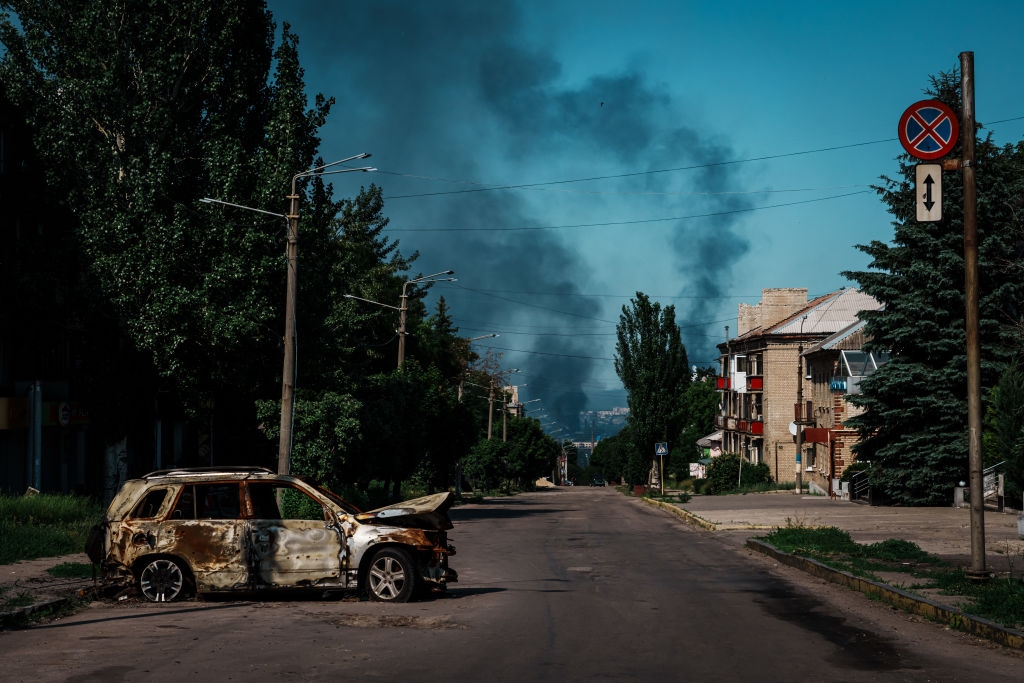
The Battle of Donbas, meanwhile, enters a new phase, as Ukraine's military makes a painful yet long-anticipated decision — withdrawing from the last patches of the city of Sievierodonetsk. As a result, Russia gains a tactical victory and gets closer to its goal of capturing the whole of Luhansk Oblast.
July
Lysychansk, the last city under Ukrainian control in Luhansk Oblast, falls to Russia in the first days of July.
Russia continues to launch deadly attacks against civilians. A missile strike at Vinnytsia, a regional capital in west-central Ukraine, kills 27 and injures more than 200 people on July 14. The attack comes five days after the missile strike at a five-story apartment building in Chasiv Yar, Donetsk Oblast, kills 48 people.
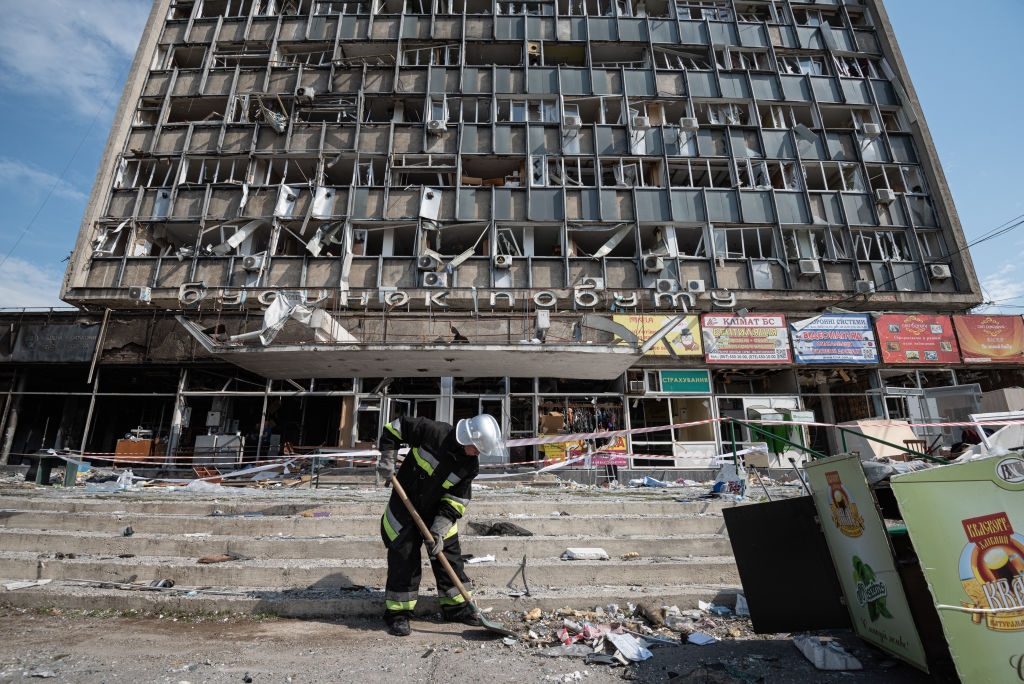
After two months of the UN and Turkey working closely with Ukraine and Russia to broker a grain deal, the parties finally sign an agreement to unblock exports of Ukrainian grain through the Black Sea. The deal envisioned the safe passage of the grain from three southwestern ports in Odesa Oblast, including the one in Odesa. A day after signing the deal, Russia compromises it by attacking Odesa port with missiles.
Over 50 Ukrainian prisoners of war are killed in an explosion in Russian-occupied Olenivka, Donetsk Oblast, marking possibly the worst crime against captive combatants since Russia launched its full-scale war.
Ukrainian authorities say that the attack could be specifically targeted at the members of the Azov regiment, who were captured in Mariupol and awaiting a prisoner exchange. Ukraine claims that Russians singled out these soldiers, moving them to a separate part of the prison building that was ultimately destroyed.
August
Ukraine announces it's coming to liberate Kherson, the only regional capital Russia managed to seize since the start of the full-scale invasion.
As Kyiv acquires advanced Western weapons, including High Mobility Artillery Rocket Systems, or HIMARS, provided by the U.S., it begins to take out Moscow's key military infrastructure in the occupied territories. With almost every nightfall, videos of massive detonations at Russian ammunition depots in Kherson Oblast and Donbas pop up on social media.
In the east, heavy fighting is ongoing in Donetsk Oblast. As the hostilities intensify, Ukraine carries out a mandatory evacuation of residents from the war-torn region.

Meanwhile, Russia is turning the Zaporizhzhia Nuclear Power Plant in occupied Enerhodar into a ticking bomb, putting nuclear safety at risk with its constant shelling.
September
Ukraine retakes much of the northeastern Kharkiv Oblast in a rapid surprise counteroffensive and seizes the initiative in the war. The Armed Forces also gain more ground in the southern Kherson Oblast.
With the Russian retreat, new evidence of war crimes comes to light as mass burial sites with multiple graves, and torture chambers are discovered.
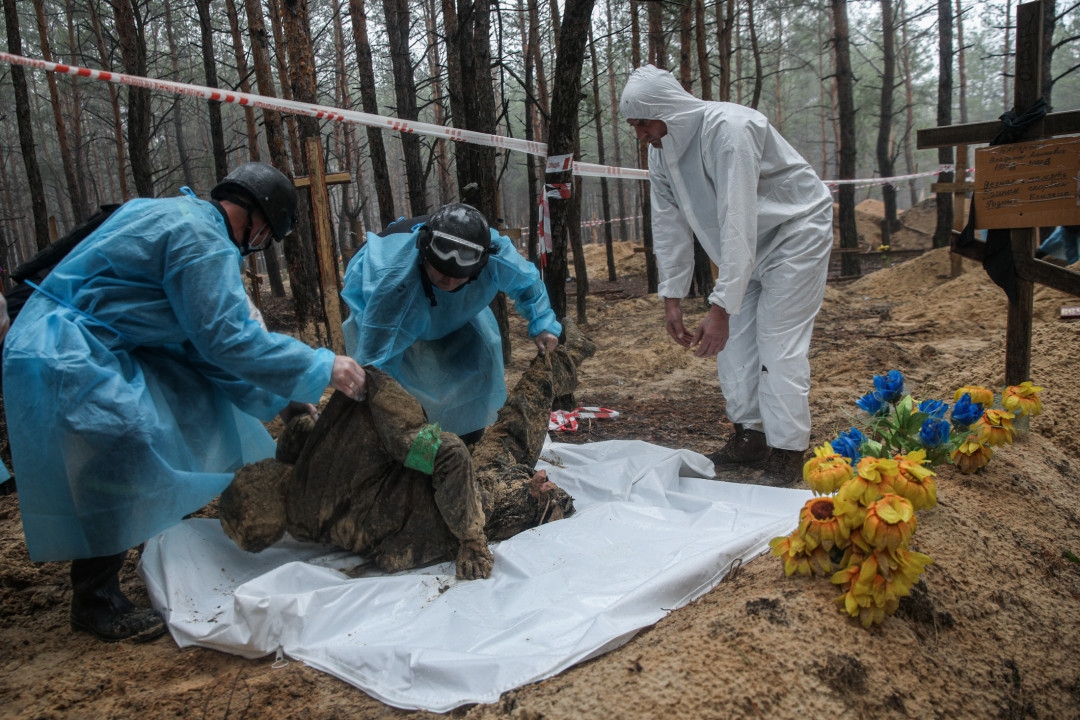
In a major prisoner swap, Ukraine returns 215 prisoners of war, including some of the Azovstal defenders. Kyiv gets 200 prisoners of war in exchange for Viktor Medvedchuk, Ukraine's most high-profile pro-Kremlin politician and Putin's former right-hand man in the country. Medvedchuk was arrested in April on the charges of high treason.
After Kyiv's lighting counteroffensive in the northeast, Putin declares a “partial mobilization” in Russia. Just five days into Moscow's attempt to mobilize Russians to fight against Ukraine, over 260,000 Russian men flee the country.
At the same time, the Kremlin-installed proxies in the occupied parts of Luhansk, Donetsk, Kherson, and Zaporizhzhia oblasts announce they will hold "referendums" on these regions joining Russia. Moscow, however, only partially controls these regions.
The proxies claim that nearly 100% of the people living in the four oblasts voted to join Russia in what many describe as the vote at gunpoint. On Sept. 30, Putin declares the annexation of the four oblasts.
On the same day, Zelensky announces that Ukraine applies for fast-track NATO accession.
Meanwhile in Europe, four leaks are discovered in the Nord Stream pipelines, which were built to carry gas from Russia to Germany under the Baltic Sea.
NATO calls Nord Stream leaks “deliberate acts of sabotage.” Moscow has been regularly accused of weaponizing its gas to blackmail European countries, a policy that intensified after Russia’s full-scale invasion of Ukraine.
October
The Crimean Bridge, which was illegally built after Russia’s occupation of the peninsula in 2014, gets damaged in an explosion. Moscow blames Ukraine for the attack, while Kyiv denies being behind it.
Just two days later, Russia launches a campaign to cripple Ukraine's energy infrastructure. Moscow openly admits that Ukraine's energy facilities are one of its key targets ahead of winter, effectively admitting targeting the livelihood of the civilian population.
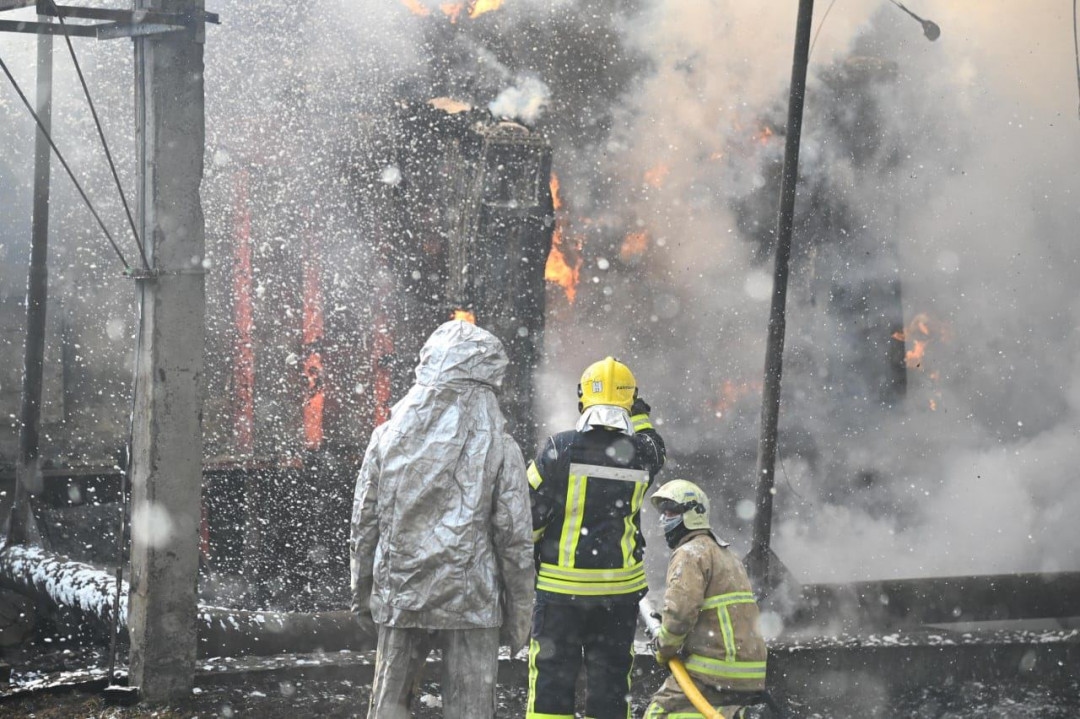
During the first two days of the attacks, on Oct. 10-11, Russia launches a barrage of 83 missiles and 24 Iranian-made kamikaze drones. The major coordinated strike targets critical infrastructure in multiple cities across Ukraine, including Kyiv, Lviv, and Dnipro, resulting in over 20 deaths and over 100 injuries.
The attack causes significant damage to the country's energy infrastructure, hitting 30% of it. Rolling blackouts are introduced across Ukraine to manage the power deficit.
November
After a months-long Ukrainian campaign of striking Russian logistic routes and bridges in the south, Russian forces are ordered to retreat from Kherson, the only major city they occupied since Feb. 24.
Ukraine's liberation of Kherson becomes the most far-reaching Ukrainian success since the Battle of Kyiv. The defeat is humiliating for Kremlin, which claimed sovereignty over the region a bit over a month ago after the sham referendum.

Following the liberation of the southern regional capital, Zelensky proposes his 10-point peace plan to G20 leaders. His plan calls for full Russian withdrawal, the return of all prisoners and deportees, food, energy, nuclear security, and justice for Russian war crimes, among other requirements.
Ukraine also receives long-anticipated Western air defense systems, such as NASAMS and Aspide, as the country braces itself for new Russian missile and drone attacks.
As of mid-November, almost half of Ukraine's energy system is out of order due to the massive Russian strikes, according to Prime Minister Denys Shmyhal. Scheduled blackouts are in place across the country.
For the first time since February, a missile hits NATO territory. On Nov. 15, during a massive nationwide Russian attack against Ukraine, a blast kills two people in the Polish village of Przewodow, about six kilometers west of the Ukrainian border. NATO and Poland say that it is likely a Ukrainian air defense missile that landed on Polish territory, though nobody accuses Kyiv of a deliberate attack. Kyiv denies it and sends experts to investigate the site.
December
Donbas, particularly the area of Bakhmut in the eastern Donetsk Oblast, remains the site of the fiercest battles, but the front line makes little changes.
Ukraine uses drones to strike airbases deep inside Russia, and several Russian strategic bombers get damaged.
The West increases aid for Ukraine. The EU approves an 18 billion euro macro-financial aid package.
Zelensky makes the first trip abroad since February. During a historic visit to Washington, D.C., he meets with Biden and addresses the U.S. Congress. The U.S. announces a new $1.85 billion military aid package for Ukraine, including the first long-sought Patriot air defense system.
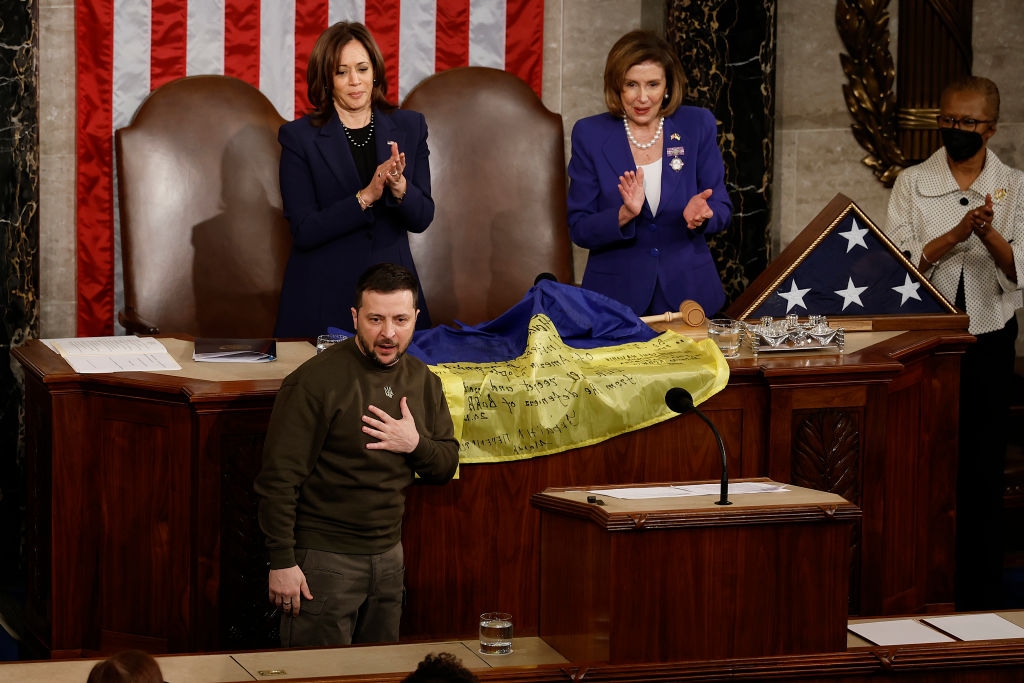
Moscow continues its campaign against Ukraine's energy infrastructure, and by the middle of the month, all thermal and hydroelectric power plants in the country are damaged. Hours-long blackouts are a new reality for many Ukrainian cities.
On New Year's Eve, Russia intensifies its missile and drone attacks, finishing the year by killing, wounding, and displacing civilians. The deadliest attack was witnessed in Kyiv, where one person was killed, and 21 were injured.
January
Ukraine's Armed Forces strike on the Russian troops' quarters in occupied Makiivka in Donetsk Oblast. Kyiv puts the death toll from the strike at 400 Russian soldiers, while Moscow says 89 of their service members were killed.
Meanwhile, the Russian attacks on civilian areas continue in early 2023, with the strike at an apartment building in the central city of Dnipro resulting in the death of 46 people.
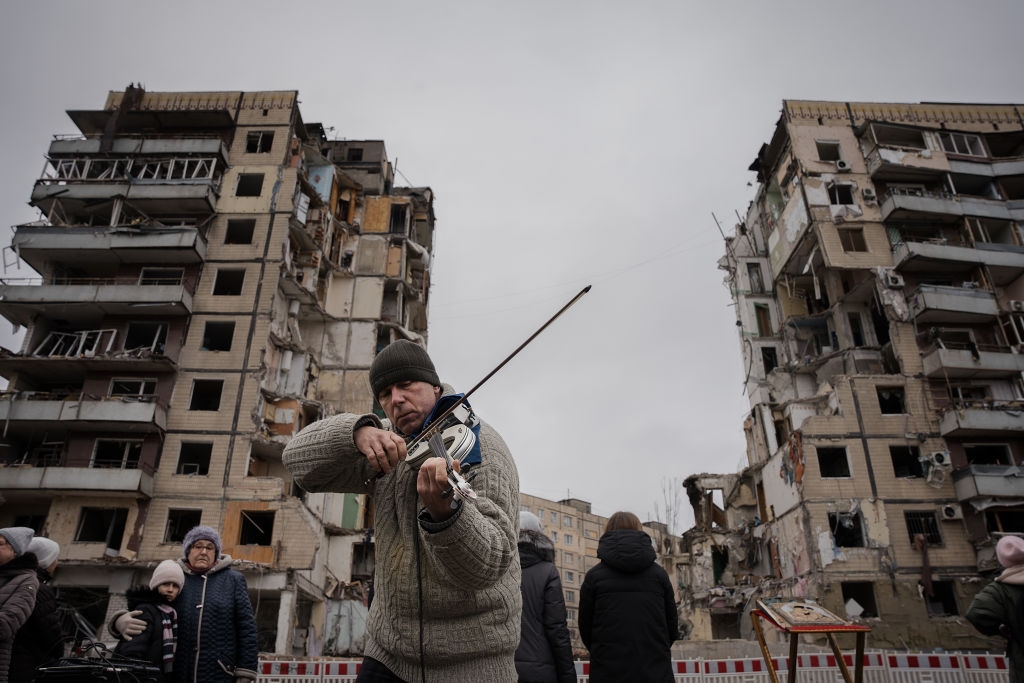
On Jan. 18, a helicopter carrying Ukraine's Interior Ministry top officials crashes next to a kindergarten and an apartment building in Brovary, a city just east of Kyiv, claiming the lives of 14 people, including all 10 people onboard. Interior Minister Denys Monastyrsky was the most senior Ukrainian official killed since the start of Russia’s full-scale invasion. While the crash hasn’t been proven to be directly linked to the war and the investigation is ongoing, Zelensky believes that "it wasn't just an accident" and “is the result of war.”
On the battlefield, Russian forces managed to seize what's left of the industrial town of Soledar near Bakhmut after fierce urban fighting. The situation in Bakhmut, which became known as the Ukrainian fortress city in the east, becomes even more complicated. Russia’s reported losses are staggering, with the Ukrainian military estimating around 150 are killed and as many wounded on an average day of Russia’s grinding attacks on the city. While Ukraine isn’t disclosing its own casualty figures, reports suggest they also suffer heavy losses.
After months of Kyiv’s pleas, the West agrees to supply Kyiv with modern tanks. U.S. President Joe Biden announces the delivery of M1 Abrams tanks. The U.K. pledges to deliver Challenger 2 main battle tanks, and Germany confirmes the supply of Leopard 2 tanks. Berlin authorizes other countries’ delivery of Leopards to Kyiv as well.
Ukraine also sees the biggest governmental reshuffle since the start of the full-scale war in the wake of scandals, some of which are related to corruption. A deputy head of the President's Office, a deputy prosecutor general, several deputy ministers, and several governors are ousted.
February
President Volodymyr Zelensky goes on a brief yet busy trip to Europe to consolidate support ahead of the war anniversary. His trip begins with a surprise visit to London, followed by an overnight stay in Paris, where he met with French counterpart Emmanuel Macron and German Chancellor Olaf Scholz.
In a historic visit to Brussels, Zelensky addresses the European Parliament, saying that the EU and Ukraine are fighting together against the “biggest anti-European force of the modern world."
Fighting intensifies in the east, as Intelligence reports indicate that Putin has instructed his troops to seize the entire Donetsk Oblast by March. Zelensky warns Russia plots a revenge attack for last year's defeats.
National Security and Defense Council Secretary Oleksiy Danilov says Russia has begun its new major offensive in Ukraine's east but faces "big problems" with it. The battle for Bakhmut is ongoing, and the Kremlin-controlled Wagner mercenary group that tries to seize the city along with the regular army admits the fighting is far from over.
As Ukraine prepares for a new counteroffensive in spring, Western countries commit to providing hundreds of modern battle tanks to Kyiv. Pentagon head says allies will help Ukraine with a counterattack by delivering pledged weaponry shortly.
Just days before the one-year anniversary of Russia's full-scale invasion of Ukraine, Biden pays a surprise visit to Kyiv in a show of "unwavering" support. He pledges $500 million in additional military aid for Ukraine.

“Putin thought Ukraine was weak and the West was divided,” Biden said, standing alongside Zelensky in Kyiv.
“One year later, the evidence is right here in this room. We stand here together,” he went on.
"One year later, Kyiv stands. And Ukraine stands. Democracy stands."
___________________________________________________________________________________________________________________________
Note from the author:
Thank you for taking the time to read this story. It has been a hell of a year, and reporting on these events has been a real challenge. Still, our team has risen to the occasion, putting all our efforts into bringing you quality journalism to keep you informed about Russia's war against our country.
To sustain our work and continue telling the stories that matter, we need your support. If you find our reporting valuable, we encourage you to consider becoming the Kyiv Independent's patron. Thank you again for your support.


